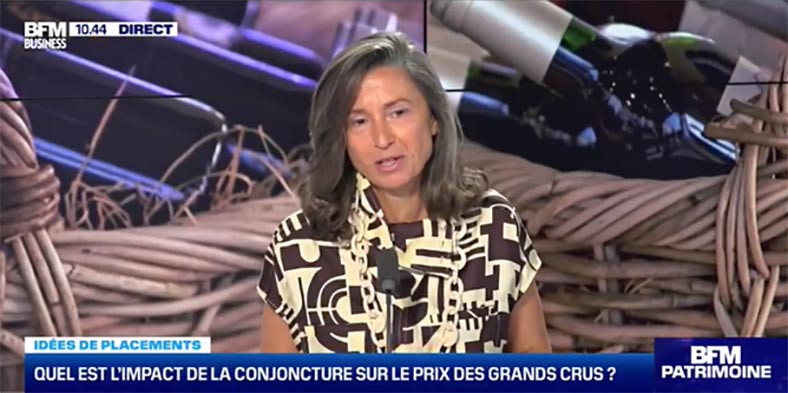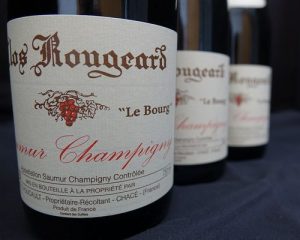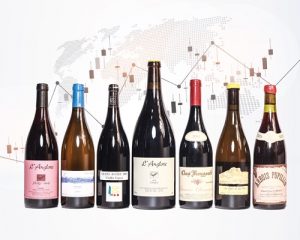
Once a month, Angélique de Lencquesaing goes on the BFM Business segment to talk about the current dynamics in the fine wine market. This time, she was interviewed by Cédric Decoeur.
Cédric Decoeur: You follow the fine wine market really closely. Today, we’re going to look at how far this market has been impacted by the economic and geopolitical situations we’re seeing evolve at present.
There’s a lot to cover…
First question: since the outbreak of war in Ukraine, have you noticed any effects in the auction world?
It would be misplaced to link developments on the fine wine market to the invasion of Ukraine, especially as the market’s good health could appear paradoxical. However, looking back at the past six months, it’s more the economic situation, in part brought about by the war, that could have repercussions.
There are three main factors to consider: interest rates, the euro, and the rise of inflation. All of this in a generally anxious context that these developments have done nothing to appease.
What are the consequences of these factors on the market?
Since we’ve been building this expertise for over 20 years, we’ve observed the wine market through several economic and stock market crises. Each time, wine has revealed its strength as a safe investment. As is often the case for material assets like real estate and luxury items, their value increases, whist lower-valued products are much harder to sell. Wine buyers concentrate their purchases on landmark names in the finest signatures, those that age well.
So far, we’ve observed the same thing this year, with a higher concentration of purchases in recent months. The price effect is colossal. Across the first semester, for a stable volume of bottles auctioned, the total value sold has soared by 65%!
Are we still talking about the same signatures, those from Burgundy, the Rhône, and Bordeaux?
Yes and no. The wines that made headlines in 2021 have stayed record-breakers for the year so far. Domaine de la Romanée-Conti, Rousseau, Roumier, and Leroy in Burgundy, Rayas and Chave from the Rhône, and Petrus in Bordeaux all spring to mind. These estates still get the most interest from bidders across the world. In the context of a weak euro, the fine wine auction market is carried by the effect of the exchange rate.
However, bidders are also on the hunt for rare treasures, some of these being largely understated wine estates that use natural methods, for example. Bizot, Prieuré-Roch, and Les Horées are among those I’d cite, alongside plenty of domains from outside the three traditional regions.
Still, if interest rates are increasing, wine loses some of its interest, no?
Wine has a characteristic that makes it stand out from other luxury products that people might invest in: it’s a living product, made to be consumed. This is unlike a bag, for example, that’s made to last for as long as possible. This means that, over the years, wines necessarily become more rare when they’re not consumed. Even if the market turns, if rates increase, if buyers turn away from the fine wine market, the very rarest and most prestigious bottles remain attractive. Their value increases as the offer decreases, compared to demand that becomes ever more global.
Can you measure this evolution?
I can give you an example. If we look back at a period of fifteen years, we’ve recorded some impressive results. I’ve already spoken about the Musigny cuvée from Leroy, which is currently the highest priced bottle ever sold at iDealwine. In 2005, in its 1999 vintage, this wine sold for €536 at auction. In the first half of 2022, a bottle from the same parcel, this time in it 2006 vintage, fetched no less than €33,000. Even removing inflation from the picture, very few products perform in this way on the market.
So is there any point investing in wines that aren’t of this calibre? Or are there some good opportunities at the moment?
Opportunities do tend to come up in times of crisis. Some buyers will focus their purchases even more on the top end bottles, leaving more space for other options, many of which represent excellent investments. Wine collectors should be looking out for the rising stars of tomorrow from lesser-known regions, especially as wine production at large is become gradually rarer.
Speaking of rarity, what are the first impressions of the 2022 harvest?
The recent rarity in wine production comes from the past two or three vintages, years that have been marked by destructive weather episodes. Many domains lost a significant proportion of their harvest, including some of Burgundy’s most prestigious names, who have lost the equivalent of a whole vintage over the past four years.
The 2022 harvest isn’t yet finished everywhere, although it has been a premature vintage. We’ll perhaps revisit the question next month, but what we’ve heard from Bordeaux, for example, is that volumes are lower than expected. This is due to high temperatures this summer that caused evaporation on the vines, which concentrated the grapes. The harvest looks like a good one, but microscopic in areas that didn’t get the welcome rainy spells at the start of September. In Burgundy, the harvest has been more abundant and very successful, the same for Champagne where stocks have been getting low. But of course, we’re talking about wines that will be ready and available in a few years’ time. In the meantime, the domains will have to manage the wine shortage they’re already facing.
Shop our latest selections here
Find out more about selling your wines




